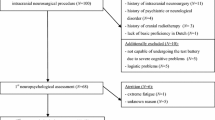Abstract
Purpose
The purpose of this study is to provide longitudinal data on neurological and neuropsychological restitution following resection of an extra-axial space-occupying lesion.
Case report
A comprehensive neuropsychological test battery was utilised preoperatively and 1, 4, 11, and 24 months, respectively, after removal of a parasagittal meningioma compressing the right frontal lobe in a right-handed 6-year-old boy with average intelligence.
Results
Symptoms related to brain compression (left-sided hemiparesis, diplopia) resolved shortly after surgery. Recovery of specific cognitive functions (short- and long-term memory, attention, and dichotic listening performance) was more protracted.
Conclusion
Here, we illustrate the potential of a structured follow-up analysis, based on neuropsychological testing. We were able to distinguish separate time-courses for neurological functions but even more distinct within complex neuropsychological processes. This time-dependent recovery should be considered when designing longitudinal follow-up studies.


Similar content being viewed by others
References
Marosi C, Hassler M, Roessler K, Reni M, Sant M, Mazza E, Vecht C (2008) Meningioma. Crit Rev Oncol Hematol 67:153–171
Rushing EJ, Olsen C, Mena H, Rueda ME, Lee YS, Keating RF, Packer RJ, Santi M (2005) Central nervous system meningiomas in the first two decades of life: a clinicopathological analysis of 87 patients. J Neurosurg 103:489–495
Gupta R, Suri V, Jain A, Sharma MC, Sarkar C, Singh MM, Joshi NP, Puri T, Julka PK (2009) Anaplastic meningioma in an adolescent: a report of a rare case and brief review of literature. Childs Nerv Syst 25:241–245
Hugdahl K, Carlsson G, Uvebrant P, Lundervold AJ (1997) Dichotic-listening performance and intracarotid injections of amobarbital in children and adolescents. Preoperative and postoperative comparisons. Arch Neurol 54:1494–1500
Posner MI, Petersen SE (1990) The attention system of the human brain. Annu Rev Neurosci 13:25–42
Fan J, McCandliss BD, Fossella J, Flombaum JI, Posner MI (2005) The activation of attentional networks. Neuroimage 26:471–479
Hugdahl K, Westerhausen R, Alho K, Medvedev S, Laine M, Hamalainen H (2009) Attention and cognitive control: unfolding the dichotic listening story. Scand J Psychol 50:11–22
Cattell RB, Weiss HR, Osterland J (1997) CFT1—Grundintelligenztest Skala 1. Testzentrale, Göttingen
Trites RL (1977) Neuropsychological test manual. Technolab, Montreal
Beery KE (1989) The VMI-developmental test of visual-motor integration. Modern Curriculum Press, Cleveland, OH
Kimura D (1961) Some effects of temporal-lobe damage on auditory perception. Can J Psychol 15:156–165
Niccum N, Speaks C (1991) Interpretation of outcome on dichotic listening tests following stroke. J Clin Exp Neuropsychol 13:614–628
Hugdahl K, Andersson L (1986) The “forced-attention paradigm” in dichotic listening to CV-syllables: a comparison between adults and children. Cortex 22:417–432
Hugdahl K, Bodner T, Weiss E, Benke T (2003) Dichotic listening performance and frontal lobe function. Cogn Brain Res 16:58–65
Wechsler D (1999) WISC-III: Wechsler intelligence scale for children. Huber, Göttingen
Carlsson G (1997) Memory for words and drawings in children with hemiplegic cerebral palsy. Scand J Psychol 38:265–273
Rugland AL (1990) Neuropsychological assessment of cognitive functioning in children with epilepsy. Epilepsia 31(Suppl 4):S41–S44
Carlsson G, Hugdahl K, Uvebrant P, Wiklund LM, von Wendt L (1992) Pathological left-handedness revisited: dichotic listening in children with left vs right congenital hemiplegia. Neuropsychologia 30:471–481
Hugdahl K, Carlsson G (1996) Dichotic listening performance in a monozygotic twin pair with left- and right-sided hemiplegia. Neurocase 2:141–147
Rypma B, Berger JS, D’Esposito M (2002) The influence of working-memory demand and subject performance on prefrontal cortical activity. J Cogn Neurosci 14:721–731
Anderson V, Jacobs R, Harvey AS (2005) Prefrontal lesions and attentional skills in childhood. J Int Neuropsychol Soc 11:817–831
Godefroy O (2003) Frontal syndrome and disorders of executive functions. J Neurol 250:1–6
Desmurget M, Bonnetblanc F, Duffau H (2007) Contrasting acute and slow-growing lesions: a new door to brain plasticity. Brain 130:898–914
Tulving E, Kapur S, Markowitsch HJ, Craik FI, Habib R, Houle S (1994) Neuroanatomical correlates of retrieval in episodic memory: auditory sentence recognition. Proc Natl Acad Sci U S A 91:2012–2015
Deutsch G, Papanicolaou AC, Bourbon WT, Eisenberg HM (1987) Cerebral blood flow evidence of right frontal activation in attention demanding tasks. Int J Neurosci 36:23–28
Posner MI (1994) Attention: the mechanisms of consciousness. Proc Natl Acad Sci U S A 91:7398–7403
Arruda JE, Walker KA, Weiler MD, Valentino DA (1999) Validation of a right hemisphere vigilance system as measured by principal component and factor analyzed quantitative electroencephalogram. Int J Psychophysiol 32:119–128
Briere ME, Scott JG, Nall-Knapp RY, Adams RL (2008) Cognitive outcome in pediatric brain tumor survivors: delayed attention deficit at long-term follow-up. Pediatr Blood Cancer 50:337–340
Acknowledgements
This research was gratefully supported by Barnhuset in Göteborg, Sweden, to GC. We gratefully acknowledge Prof. Kenneth Hugdahl, Department of Biological and Medical Psychology, University of Bergen, Norway, and Division of Psychiatry, Haukeland University Hospital, Bergen, Norway, for his support and critical reading.
Disclosure
The authors do not report any conflict of interest concerning materials or methods used in this study or the findings identified in this paper.
Author information
Authors and Affiliations
Corresponding author
Rights and permissions
About this article
Cite this article
Carlsson, G., Hufnagel, M., Jansen, O. et al. Rapid recovery of motor and cognitive functions after resection of a right frontal lobe meningioma in a child. Childs Nerv Syst 26, 105–111 (2010). https://doi.org/10.1007/s00381-009-0984-6
Received:
Published:
Issue Date:
DOI: https://doi.org/10.1007/s00381-009-0984-6




